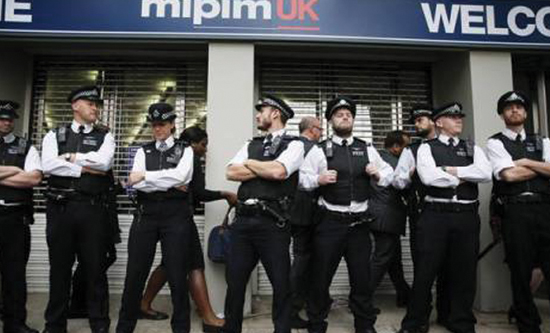
Scotland has the ‘most concentrated, most inequitable, most unreformed and most undemocratic land ownership system in the entire developed world’ (Professor James Hunter, The Guardian, 2013). Around 432 families own half the land in Scotland. The Global Justice Now report, Scotland’s land barons and their connections to global capitalism published in August 2016, has shown Scotland’s land system is not simply a ‘feudal relic’ but very much part of a global parasitic capitalism (imperialism) with ‘billionaire oilmen and Emirati princes, mineral conglomerates, London property speculators, online clothing retailers, Swiss bankers, and financiers of every sort’ claiming a stake alongside the Dukes of Buccleuch and Argyll.
Landowners in Scotland are notoriously hard to identify, with almost 750,000 acres of land held through a series of opaque offshore companies. The SNP government has been criticised by land campaigners for giving carte blanche to rich industrialists buying up vast swathes of Scotland’s countryside. Under pressure it has set a target of publicly registering all landowners by 2024. Some landowners have already been exposed by Global Justice Now as having links to colonial style racism through land grabs, exploitation, human rights abuses and environmental destruction:
- One of Britain’s wealthiest families, the Vestey family (Assynt estate, 55,000 acres near Lochinver in south west Sutherland), responsible for ethnic land clearances, worker exploitation and abuse in Australia and Venezuela. In 2005, Chavez’s Venezuelan government confiscated 3,000 hectares of Vestey land to allow indigenous people to move around freely. Since then Venezuela has been ordered by international courts to pay the Vesteys compensation.
- The Van Vlissingen family (Letterewe estate, 85,000 acres at Wester Ross in Rossshire), owners of conglomerate SHV Holdings, the largest privately-owned trading company in Europe, charged by an Ethiopian government minister with attempting to privatise Africa’s national parks.
- Rio Tinto (aluminium smelter and mountainous area, 117,000 acres around Fort William in Lochaber), a British-Australian multinational and one of the world’s largest metals and mining corporations, with a long record of support for dictatorships and human rights abuses, including land grabs and ‘slave-like’ worker exploitation across Africa.
- Majid Jafar (Pitmain estate, 12,000 acres near Kingussie in Invernesshire), CEO of Crescent Petroleum, the Middle East’s oldest private oil and gas company, a key investor in post-2003 Iraq and the biggest oil investor in Iraqi Kurdistan.
Dominic Mulgrew
Who owns the housing?
Scotland has a housing crisis. The preventive ‘housing options’ approach to homelessness encouraged by the Scottish National Party (SNP) government since 2011, and now adopted by many local authorities, is essentially a sticking plaster on the wound left by the huge sell-off of council housing to private interests over previous decades. This includes the transfer (privatisation) of Glasgow’s entire public housing stock to Glasgow Housing Association in 2003.
The SNP finally abolished Margaret Thatcher’s 1980 ‘Right to Buy’ policy at the end of July this year. This is a case of closing the stable door after the horse has bolted, as much of the public housing stock has already been lost; it represents a tokenistic gesture to appease the party’s left-leaning members more than an attempt to address the housing crisis.
The consequence of privatisation and lack of new publicly-funded house building has been a doubling of privately-rented homes in Scotland in the last ten years (Shelter Scotland, September 2016). In 1981, 63.2% of Glasgow’s population lived in council housing but according to current estimates almost 70% of Glasgow’s total housing stock will be in the private sector by 2018). Around 700,000 people in Scotland currently live in private rented homes.
According to Shelter the 150,000 households on local authority housing waiting lists across Scotland underestimates the true level of need. The total number of homes built in 2014-15 reflects the growth trend in the private sector: housing association, 3,064; local authority, 1,157, and private sector, 12,060. Since 2015 Shelter has been calling for 12,000 new ‘socially rented’ homes to be built per annum over the next five years. Alongside this demand for homes there are currently 34,000 long-term private empty homes in Scotland.
The standard of housing – much of it not fit for human habitation – becomes the next issue. One in ten households in Scotland is affected by damp and/or condensation. 74,000 households are overcrowded, with at least 845,000 households in fuel poverty. Yet there has been no comparable downward trend in rent. Between 2004-2014 average house prices in Scotland increased by 61%. Average weekly rents for local authority housing increased by 46%.
Land prices themselves have been rocketing as land developers and property speculators search to find a profitable outlet for their unused capital. Savills UK reported a 12% increase in the value of greenfield land across Scotland over 2014 and as much as a 10% increase in the value of land in Edinburgh in the last quarter of 2014 alone. In Glasgow urban and greenfield land in high-value areas surrounding the city has also seen large increases in values (Lucy Greenwood, ‘Land value growth in UK hotspots’, 19 February 2015).
While the official number of homeless applications (34,662 in 2015-16) has been falling, Shelter Scotland argues that the underlying drivers of homelessness are not being addressed. According to Crisis this includes an increase in economic deprivation fuelled by attacks on welfare and wages alongside the increased cost of living. From December 2014 to March 2016 there was a 20% rise in the number of children living in temporary accommodation in Scotland. The total number of people living in temporary accommodation was 10,555. Charities in Glasgow and Edinburgh have reported 94% and 40% increases in demand for their winter shelters over the last year and it is estimated that at least 660 people sleep rough in Scotland on any one night.
The sight of people begging and sleeping rough throughout Scotland’s major cities is becoming a lot more common. This is only the seeping wound of a crisis that goes much deeper.
Dominic Mulgrew
Fight Racism! Fight Imperialism! 253 October/November 2016




